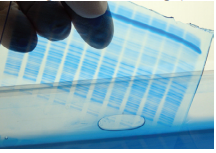Question:
How do you perform protein electrophoresis?
The Protein Man Says:
Protein electrophoresis is commonly used in determining the characteristics (size, isoelectric point and enzymatic activity) of the protein of interest which may be present in a fluid or extract. This process is commonly used in the fields of analytical chemistry, biochemistry and molecular biology since it is one of the simplest yet most effective tools that can be used in analyzing the various properties of proteins.
 Protein electrophoresis may be performed using a small amount of sample in a variety of ways and regardless of the presence (or absence) of a supporting medium. It can be used for a wide range of applications including protein purification, purity determination, immunological detection and to provide data on the regulation of protein expression.
Protein electrophoresis may be performed using a small amount of sample in a variety of ways and regardless of the presence (or absence) of a supporting medium. It can be used for a wide range of applications including protein purification, purity determination, immunological detection and to provide data on the regulation of protein expression.
Understanding the Protein Electrophoresis Workflow
How do you separate your protein of interest from your sample? The process can be broken down into five distinct steps – instrument selection, sample preparation, gel and buffer selection, the actual electrophoresis procedure and protein detection and analysis.
Instrument selection. While proteins can be separated through electrophoresis using a wide variety of methods, matrices and buffer systems, you need to take your goals, desired throughput and resolution into account when choosing the method you want to use. Depending on what your purpose and intended results are, you can use the denaturing gel methods, the native or non-denaturing gel methods or a combination of the two (two dimensional PAGE) in studying your protein of interest.
If you want to break down the protein and examine the polypeptide composition of your sample, you should choose the denaturing method (sodium dodecyl sulfate-polyacrylamide gel electrophoresis or SDS-PAGE). You should also determine whether you need to use a continuous or discontinuous buffer system to achieve your goals using this method. Keep in mind that discontinuous buffer systems yield higher resolutions and can be used for a variety of applications while the continuous buffer system is best used if you analyzing nucleic acids.
On the other hand, if you want to separate the protein components based on their mass and native charge while preserving protein function and activity, then you should use non-denaturing methods instead.
We will be discussing the succeeding steps involved in protein electrophoresis on our next blog so watch out for it.






